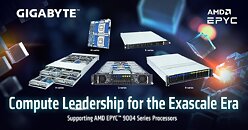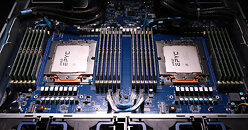- Joined
- Oct 9, 2007
- Messages
- 47,559 (7.46/day)
- Location
- Dublin, Ireland
| System Name | RBMK-1000 |
|---|---|
| Processor | AMD Ryzen 7 5700G |
| Motherboard | ASUS ROG Strix B450-E Gaming |
| Cooling | DeepCool Gammax L240 V2 |
| Memory | 2x 8GB G.Skill Sniper X |
| Video Card(s) | Palit GeForce RTX 2080 SUPER GameRock |
| Storage | Western Digital Black NVMe 512GB |
| Display(s) | BenQ 1440p 60 Hz 27-inch |
| Case | Corsair Carbide 100R |
| Audio Device(s) | ASUS SupremeFX S1220A |
| Power Supply | Cooler Master MWE Gold 650W |
| Mouse | ASUS ROG Strix Impact |
| Keyboard | Gamdias Hermes E2 |
| Software | Windows 11 Pro |
GIGABYTE Technology, an industry leader in high-performance servers and workstations, today announced its portfolio of products ready to support the new AMD EPYC 9004 Series Processors in the first wave of GIGABYTE solutions that will target a wide range of demanding workloads that include GPU-centric, high-density, edge, and general computing. A new x86 platform, a new socket, and a wealth of highly performant technologies provided new opportunities for GIGABYTE to tailor products for leading data centers. So far, GIGABYTE has released twenty-two new servers and motherboards to support the new AMD "Zen 4" architecture. Both single-socket and dual-socket options are available to handle big data and digital transformation. The ongoing collaboration between GIGABYTE and AMD has allowed for a comprehensive portfolio of computing solutions that are ready for the market.
The new 4th Gen AMD EPYC processors feature substantial compute performance and scalability by combing high core counts with impressive PCIe and memory throughput. In terms of out of the box performance, AMD estimates found that 4th Gen AMD EPYC CPUs are the highest performing server processors in the worldi. With the advancement to 5 nm technology and other performant innovations, the new AMD EPYC 9004 series processors move to a new SP5 socket. The new architecture leads the way to faster data insights with high performance and built-in security features, and this platform targets HPC, AI, cloud, big data, and general enterprise IT.



Leadership core performance, compute throughput, and advanced security features
Key Generational Technologies and Advancements:
View at TechPowerUp Main Site
The new 4th Gen AMD EPYC processors feature substantial compute performance and scalability by combing high core counts with impressive PCIe and memory throughput. In terms of out of the box performance, AMD estimates found that 4th Gen AMD EPYC CPUs are the highest performing server processors in the worldi. With the advancement to 5 nm technology and other performant innovations, the new AMD EPYC 9004 series processors move to a new SP5 socket. The new architecture leads the way to faster data insights with high performance and built-in security features, and this platform targets HPC, AI, cloud, big data, and general enterprise IT.



Leadership core performance, compute throughput, and advanced security features
Key Generational Technologies and Advancements:
- 5 nm process node
- Up to 96 cores and 192 threads
- Maximum boost clock up to 4.4 GHz
- Up to 384 MB L3 cache
- Support for 12 channel DDR5-4800
- ISA updates: BFLOAT16, AVX-512, and VNNI
- Support for PCIe Gen 5, 160 lanes in 2P
- Support for CXCL 1.1+ in 64 IO lanes, with bifurcations
- Up to 4 links of Gen3 AMD Infinity Fabric (up to 32 Gbps)
- M-Series Motherboards - Single and dual socket options supporting Gen4 NVMe drives and PCIe 4.0 and/or 5.0 lanes
- R-series Rackmount Servers - 1U and 2U general-purpose systems, offering the best balance of compute, memory, storage, and expandability
- G-Series GPU Servers - 2U or 4U systems offering industry leading GPU density due to excellent thermal and mechanical design, and built for HPC, AI, and high-performance parallel processing
- H-Series High-density 2U 4-node Servers - combining four hot-swappable nodes in a 2U chassis, offering extreme CPU compute density excellent for HPC, HCI, and edge computing
- E-Series Edge Servers - 1U and 2U short depth servers with options for IO on front or rear, moving data collection away from data centers and improving latency
View at TechPowerUp Main Site
